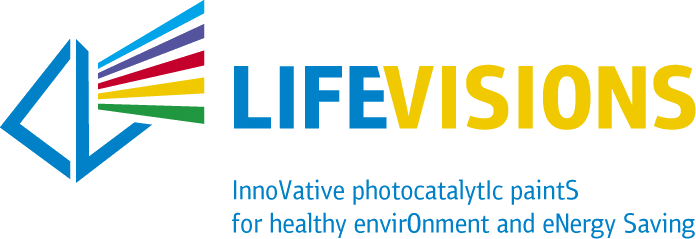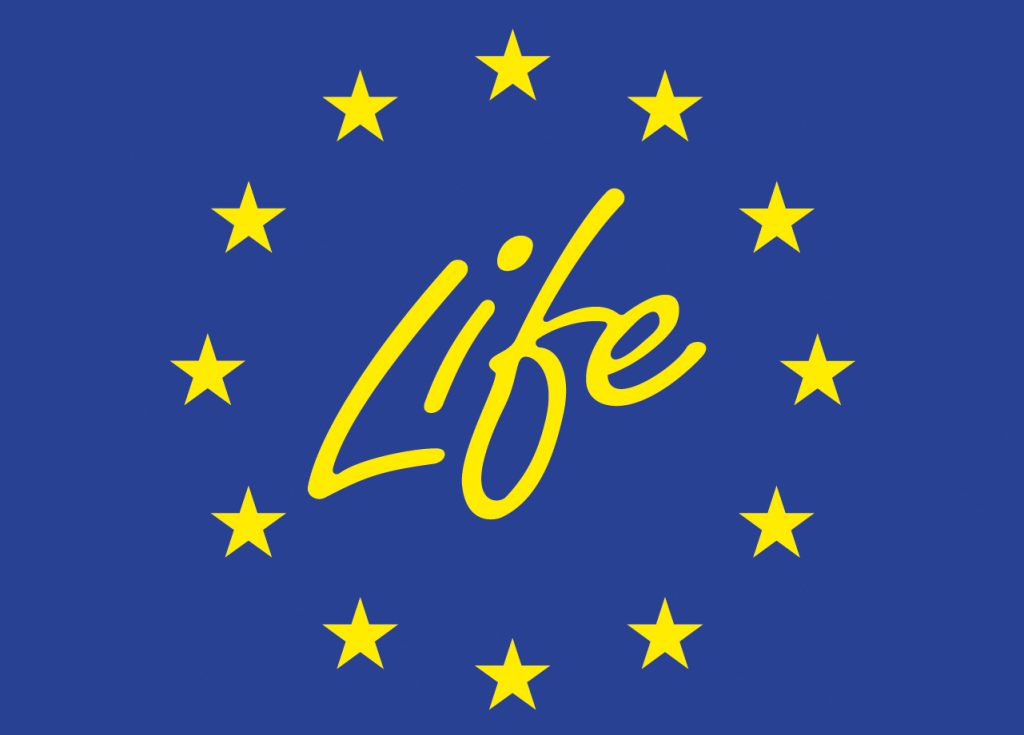LIFE-VISIONS
Implementation actions
B.1.Optimization and Upscaling of synthesis root of the novel photocatalytic powder (TCM-1)
The main objective of this sub-action is to optimize the synthesis root of the novel photocatalytic powders, which are activated in the presence of visible radiation, for enhanced performance while mixing in paints and reduce production cost.
The main objective of this sub-action is to quantify the capacity of the optimized TCM-1 to degrade photocatalytically inorganic (nitrogen oxides NOx) and volatile organic (VOCs e.g toluene) air
The main objective of this sub-action is to produce in semi industrial scale photo-paints by mixing the optimized TCM-1 powder with 3 different kinds of paints.
The main objective of the current sub-action is to quantify the capacity of the 3 different kinds of photopaints which were produced in sub-action B2.1, to degrade photocatalytically inorganic (nitric oxides NOx) and volatile organic (VOCs e.g toluene) air pollutants. In addition possible emissions of by-products during the photocatalytic reactions, such as ozone (O3) and volatile organic compounds (formaldehyde, toluene, etc.), will be investigated.
B.2.Semi-Industrial production of Photo-Paints
B.3.Real Scale Applications
The ultimate scope of the current sub-action is to estimate the effectiveness of the 3 Photo-Paints to degrade air pollutants as well as to eliminate energy consumption in the demo-houses and promote the most promising one to be used in sub-action B3.2.
The dissemination of the versatile and clear technology of photocatalysis will be manifested by applying the Photo-Paint that gave the best performance when applied and monitored in the Demo-House (Action B3.1), with regards to de-polluting efficiency for the abatement of air pollution and reduction of energy consumption, to the Hellenic Naval Academy Buildings.
As a first step, an extensive review of readily available indoor air quality measurements from previous studies in building close to the selected field trial areas will be performed. Indoor air quality data as well as data associating the operation of the HVAC systems with the air quality levels in the buildings considered in these studies will be collected and analyzed. These data will then combined and analysed based on the different type of building studied (office buildings, hospitals, schools, etc). In that basean initial estimation of the expected efficiency of the materials studied as a means for the improvement of the indoor environmental quality at an urban scale will be implemented.
An advanced Computational Fluid Dynamics (CFD) obstacle resolving model will be used to assess the effectiveness of the Photo-Paint in an integrated manner capable to account for multiscale interactions.
A Life Cycle Assessment (LCA) analysis will be contacted by assessing all environmental impacts of the proposed Photo Paint technology at all the various stages in their life cycle (extraction of raw materials, manufacturing, use, maintenance, end of life either reuse, recycling or final disposal).
Within the frame of VISIONS, both a Cost Efficiency Analysis (CEA) and a Cost Benefit Analysis (CBA) will be performed to account for the external costs of the proposed Photo-Paint technology to estimate its expected performance and usefulness and identify its weaknesses and strengths.
B.4.Numerical Modelling and Data Analysis
B.5.Development of a Decision Support System (DSS)
1.Development of VISIONS Decision Support System (DSS) which will include the outcome of CFD, LCA and CBA described above. DSS will be a tool in the hands of stakeholders and end users (Building Construction, Paint Companies, Local authorities) in order to estimate the effects of each particular photocatalytic application in the abatement of air pollutants as well as in the energy saving sector. Its main applications will be (a) the diagnosis of problems related to a particular product, (b) the comparison of improvement variants of a given product, (c) the design of new products and (d) the choice between a numbers of existing comparable products.
A detailed business plan providing analysis of marketing and exploitation opportunities available to VISIONS innovations will be provided.
Two research Centers (NCSRD, FORTH), a University (AUTH) and a private enterprise (EVOLUTION) will be joined under the umbrella of a spin-off company in order to exploit the knowledge of the VISIONS outcome.
B.6.Establishment of a spin-off company
B.1.Optimization and Upscaling of synthesis root of the novel photocatalytic powder (TCM-1)
The main objective of this sub-action is to optimize the synthesis root of the novel photocatalytic powders, which are activated in the presence of visible radiation, for enhanced performance while mixing in paints and reduce production cost.
The main objective of this sub-action is to quantify the capacity of the optimized TCM-1 to degrade photocatalytically inorganic (nitrogen oxides NOx) and volatile organic (VOCs e.g toluene) air
B.2.Semi-Industrial production of Photo-Paints
The main objective of this sub-action is to produce in semi industrial scale photo-paints by mixing the optimized TCM-1 powder with 3 different kinds of paints.
The main objective of the current sub-action is to quantify the capacity of the 3 different kinds of photopaints which were produced in sub-action B2.1, to degrade photocatalytically inorganic (nitric oxides NOx) and volatile organic (VOCs e.g toluene) air pollutants. In addition possible emissions of by-products during the photocatalytic reactions, such as ozone (O3) and volatile organic compounds (formaldehyde, toluene, etc.), will be investigated.
B.3.Real Scale Applications
The ultimate scope of the current sub-action is to estimate the effectiveness of the 3 Photo-Paints to degrade air pollutants as well as to eliminate energy consumption in the demo-houses and promote the most promising one to be used in sub-action B3.2.
The dissemination of the versatile and clear technology of photocatalysis will be manifested by applying the Photo-Paint that gave the best performance when applied and monitored in the Demo-House (Action B3.1), with regards to de-polluting efficiency for the abatement of air pollution and reduction of energy consumption, to the Hellenic Naval Academy Buildings.
B.4.Numerical Modelling and Data Analysis
As a first step, an extensive review of readily available indoor air quality measurements from previous studies in building close to the selected field trial areas will be performed. Indoor air quality data as well as data associating the operation of the HVAC systems with the air quality levels in the buildings considered in these studies will be collected and analyzed. These data will then combined and analysed based on the different type of building studied (office buildings, hospitals, schools, etc). In that basean initial estimation of the expected efficiency of the materials studied as a means for the improvement of the indoor environmental quality at an urban scale will be implemented.
An advanced Computational Fluid Dynamics (CFD) obstacle resolving model will be used to assess the effectiveness of the Photo-Paint in an integrated manner capable to account for multiscale interactions.
A Life Cycle Assessment (LCA) analysis will be contacted by assessing all environmental impacts of the proposed Photo Paint technology at all the various stages in their life cycle (extraction of raw materials, manufacturing, use, maintenance, end of life either reuse, recycling or final disposal).
Within the frame of VISIONS, both a Cost Efficiency Analysis (CEA) and a Cost Benefit Analysis (CBA) will be performed to account for the external costs of the proposed Photo-Paint technology to estimate its expected performance and usefulness and identify its weaknesses and strengths.
B.5.Development of a Decision Support System (DSS)
1.Development of VISIONS Decision Support System (DSS) which will include the outcome of CFD, LCA and CBA described above. DSS will be a tool in the hands of stakeholders and end users (Building Construction, Paint Companies, Local authorities) in order to estimate the effects of each particular photocatalytic application in the abatement of air pollutants as well as in the energy saving sector. Its main applications will be (a) the diagnosis of problems related to a particular product, (b) the comparison of improvement variants of a given product, (c) the design of new products and (d) the choice between a numbers of existing comparable products.
B.6.Establishment of a spin-off company
A detailed business plan providing analysis of marketing and exploitation opportunities available to VISIONS innovations will be provided.
Two research Centers (NCSRD, FORTH), a University (AUTH) and a private enterprise (EVOLUTION) will be joined under the umbrella of a spin-off company in order to exploit the knowledge of the VISIONS outcome.

